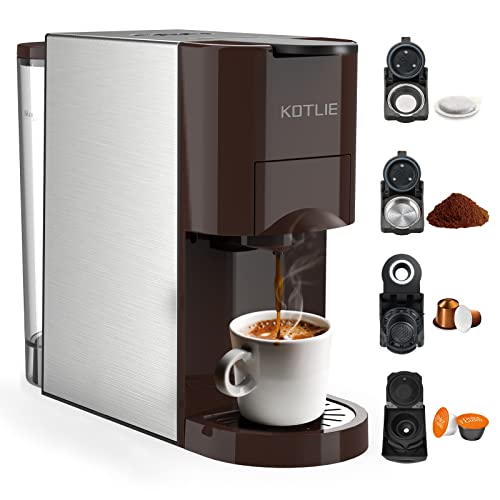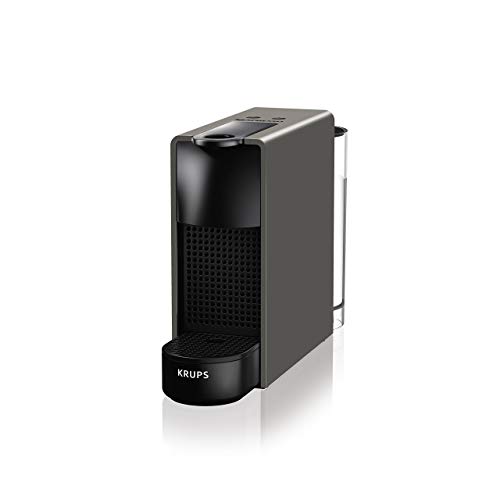5 Killer Quora Answers To Pod-Making Machines
페이지 정보

본문
Detergent pod-making machines (Read the Full Content)
From K-Cup(r) and Tassimo(tm) to Nespresso(tm) and Senseo(tm), there are a variety of pod coffee machine for pods machines to select from. All work in the same way by heating water and pressing the button.
The pod-making process is a little more complex however it's still easy enough to be done at home. Here are some of the things to look for in a pod-making machine
Detergent pod coffee maker Manufacturing
Detergent pods are convenient efficient, and also as environmentally friendly. How are they made? The process is surprisingly simple. A single-dose pod is made up of an insoluble film that dissolves when in contact with water. This film is typically made from polyvinyl alcohol, which dissolves in water and does not leave a residue on clothing. The detergent formula also contains chelating agents that soften hard water, slow down the degradation of detergents, and optical brighteners to whites.
The sachets are then sprayed with seals to protect the contents from moisture and contamination during storage, transport, and use. Laundry pod manufacturers employ high-speed production techniques to keep up with demand. They can make between 600 and 240 pods each minute. This ensures that the products meet deadlines.
Tide manufactures some of these pods. Tide makes use of high-quality, U.S-made ingredients, and does not import cheap substitutes. It also takes steps to trace and verify its raw ingredients.
A laundry pod maker machine has a product hopper which stores liquid detergent until it's needed. A precise dispenser fills each pod to the exact amount of detergent. The machine then seals each pod. The patented design of the machine protects the water-soluble film, and routine inspections maintain 0.02ml precision.
In addition to PVA The pod films also contain minor ingredients that help them fight off liquids and impart other characteristics, such as tasting awful. MonoSol for instance is made up of Bitrex, an ammonium quaternary compound known as denatonium. This chemical is so bitter that it can be a snare to humans in concentrations as low as 0.01%. It also discourages children and pets from putting sachets into their mouths.
When you're not using your laundry pods, store them out of the reach of young children or pets. By keeping them out of light and moisture, you can prevent the ingredients from degrading too fast. Proper storage conditions will also extend the life span of the detergent. In addition, always properly dispose of laundry pods after use.
Detergent Packaging of Pods
Detergent pods have become a fashion, gobbling up market share in dishwasher and laundry detergents, as well as personal care products such as shampoo. They contain a concentrated mix of surfactants and other cleaning ingredients that are encapsulated within a water-soluble film. They are simple to use, store and are a safer alternative to liquid cleaners.
In contrast to traditional detergent containers which are made of PET plastic and can contain dangerous chemicals such as 1,4-dioxane. Pods contain a cocktail of harsh chemicals surrounded by a film of polyvinyl alcohol. Depending on the brand, these chemicals may contain bleaches, surfactants, optical brighteners, solvents enzymes and fragrances. These ingredients are available on the websites of the manufacturers.
The PVA used in the film used to protect the pods is biodegradable and is listed on the Environmental Protection Agency's CleanGredients database. It also has the Nordic Swan Eco-label, which is among the most rigorous ecolabels that are independent. The EPA notes that it can be broken down into simple, natural compounds by microorganisms found in the soil and wastewater treatment plants.
Laundry pods provide an alternative to liquid detergent. There are many brands that provide a range of products, ranging from basic detergents to fabric softeners to stain removers. In the US, they make up 15 percent of the sales of household detergent, according to a study by Nohbo.
Most pods contain a single dose, but some also contain fabric softeners, stain removers, as well as scent boosters. Many manufacturers also include anti-bacterial properties in the detergent to help fight bacteria.
Despite their convenience However, some have complained that laundry pods aren't able to dissolve completely. This could be due to overfill the tub with water, use water that is unusually cool or if you introduce the pods too the early stage of the cycle. It could also occur when consumers don't read the instructions carefully, as the pods require the right temperature and pressure to dissolve properly.
They are not toys. Therefore, consumers should store them in a secure location and keep them from children. They should also be cleaned before being put in the washing machine or dishwasher. The packaging that is left behind should be recycled as soon as possible in order to reduce pollution and reduce the amount of waste.
Detergent Filling Pods
Laundry pods have become a huge success in household cleaning products, and are rapidly taking over from traditional liquid detergents. These tiny containers are convenient and easy to use, and do not require measuring. They come in a variety of sizes and strengths. Depending on the kind of laundry you use you can pick between single-dose pods and multi compartment pods or even powder detergent.
The thin film that surrounds pods is crucial to their success. It has to be able hold liquids and solids that are chemically active while retaining its shape. However, it should also be able to completely dissolve and quickly in cold water. Many firms have landed on a PVA-based polymer that has both of these properties. The rest of the pod consists of powerful detergents, bleaches and solvents. It also has optical brighteners, preservatives, enzymes and preservatives. Manufacturers typically disclose the ingredients of their detergents.
Pods are made from plant-based polymers. They are not like powder and liquid detergents that are packaged in high density plastic. Microbes are able to break down these polymers in soil and ocean water. According to scientists at the Woods Hole Oceanographic Institution, PVA is broken down in less than 70 days in sewage sludge. This is a lot faster than conventional detergent, which takes hundreds of years to degrade.
While laundry pods have revolutionized laundry, they are not without their disadvantages. One of the disadvantages is that they're more expensive than powder or liquid detergents. If you accidentally lick the pod, you'll be confronted with a sour taste as well as burning chemically.
 Another disadvantage is that they're not as flexible as traditional detergents. The laundry pods are confined to the wash cycle specified on the packaging. This could be an issue for front-loading and top-loading washers that come with an automatic fabric softener and detergent dispensers. If your coffee machine and pods is equipped with an agitator, the laundry pods may not dissolve properly.
Another disadvantage is that they're not as flexible as traditional detergents. The laundry pods are confined to the wash cycle specified on the packaging. This could be an issue for front-loading and top-loading washers that come with an automatic fabric softener and detergent dispensers. If your coffee machine and pods is equipped with an agitator, the laundry pods may not dissolve properly.
If you're considering trying laundry pods, ask an area laundromat about the best option for your machine as well as your clothes. And always be sure to read the instructions thoroughly. If your clothes have streaks or spotted after washing with a pod, immediately rewash them without adding more detergent. Never place detergent-stained clothes into dryers, as the heat can make the stains harder to remove later.
Detergent Pods Inspection
Laundry detergent pods are popular because they dissolve quickly and efficiently in hot water. They also remove the stains from all fabrics. The pods are not without controversy. Many activists refer to them as plastics and they are a major source of marine debris and litter. While it is true that polyvinyl and PVOH, which are used to make pods, are derived from oil, the producers claim that these types of plastics do not pose as much risk as other types due to the fact that they biodegrade when placed in water.
Since their introduction in 2012 the laundry pods have risen in popularity. They now account for more than one-third of liquid detergent sales in the United America. The sachets are distributed by several major brands and come in different colors and scents. They're approximately the size of an ice-cube. The pods are also marketed as eco-friendly and the Cleaning Institute (which represents large detergent multinationals like Procter and Gamble) arguing that the concentration of detergent into a pre-measured dosage results in less packaging, less weight and less shipping emissions. The manufacturers also say that the pods' starches from plants and other natural materials help to make them water-soluble and they are biodegradable in a short time in water treatment facilities.
The pods are still risky if handled incorrectly despite all the hype. The thin membranes that hold the detergent can break open easily and irritate a person's eyes or skin and, if consumed in large quantities they can cause poisoning by chemical. In addition, the outer packaging designed to prevent children from getting into the pods can easily split at the zipper track. Consumer Reports asked manufacturers to make pods safer in September 2012 by switching the transparent containers to opaque ones and introducing child-proof locks. A number of manufacturers responded and some have added additional safety warnings.
 In the meantime, to avoid any problems, keep the pods away from the reach of seniors and children and away from pets. Keep them in a high place or locked away to discourage children from mistakenly thinking they're candy, and make sure that the detergent you choose to use is compatible with your washer type. Be aware that cold water particularly if it's below 60 degrees Fahrenheit can not dissolve the pods, causing your machine to clog or leave residue on your fabric.
In the meantime, to avoid any problems, keep the pods away from the reach of seniors and children and away from pets. Keep them in a high place or locked away to discourage children from mistakenly thinking they're candy, and make sure that the detergent you choose to use is compatible with your washer type. Be aware that cold water particularly if it's below 60 degrees Fahrenheit can not dissolve the pods, causing your machine to clog or leave residue on your fabric.
From K-Cup(r) and Tassimo(tm) to Nespresso(tm) and Senseo(tm), there are a variety of pod coffee machine for pods machines to select from. All work in the same way by heating water and pressing the button.
The pod-making process is a little more complex however it's still easy enough to be done at home. Here are some of the things to look for in a pod-making machine
Detergent pod coffee maker Manufacturing
Detergent pods are convenient efficient, and also as environmentally friendly. How are they made? The process is surprisingly simple. A single-dose pod is made up of an insoluble film that dissolves when in contact with water. This film is typically made from polyvinyl alcohol, which dissolves in water and does not leave a residue on clothing. The detergent formula also contains chelating agents that soften hard water, slow down the degradation of detergents, and optical brighteners to whites.
The sachets are then sprayed with seals to protect the contents from moisture and contamination during storage, transport, and use. Laundry pod manufacturers employ high-speed production techniques to keep up with demand. They can make between 600 and 240 pods each minute. This ensures that the products meet deadlines.
Tide manufactures some of these pods. Tide makes use of high-quality, U.S-made ingredients, and does not import cheap substitutes. It also takes steps to trace and verify its raw ingredients.
A laundry pod maker machine has a product hopper which stores liquid detergent until it's needed. A precise dispenser fills each pod to the exact amount of detergent. The machine then seals each pod. The patented design of the machine protects the water-soluble film, and routine inspections maintain 0.02ml precision.
In addition to PVA The pod films also contain minor ingredients that help them fight off liquids and impart other characteristics, such as tasting awful. MonoSol for instance is made up of Bitrex, an ammonium quaternary compound known as denatonium. This chemical is so bitter that it can be a snare to humans in concentrations as low as 0.01%. It also discourages children and pets from putting sachets into their mouths.
When you're not using your laundry pods, store them out of the reach of young children or pets. By keeping them out of light and moisture, you can prevent the ingredients from degrading too fast. Proper storage conditions will also extend the life span of the detergent. In addition, always properly dispose of laundry pods after use.
Detergent Packaging of Pods
Detergent pods have become a fashion, gobbling up market share in dishwasher and laundry detergents, as well as personal care products such as shampoo. They contain a concentrated mix of surfactants and other cleaning ingredients that are encapsulated within a water-soluble film. They are simple to use, store and are a safer alternative to liquid cleaners.
In contrast to traditional detergent containers which are made of PET plastic and can contain dangerous chemicals such as 1,4-dioxane. Pods contain a cocktail of harsh chemicals surrounded by a film of polyvinyl alcohol. Depending on the brand, these chemicals may contain bleaches, surfactants, optical brighteners, solvents enzymes and fragrances. These ingredients are available on the websites of the manufacturers.
The PVA used in the film used to protect the pods is biodegradable and is listed on the Environmental Protection Agency's CleanGredients database. It also has the Nordic Swan Eco-label, which is among the most rigorous ecolabels that are independent. The EPA notes that it can be broken down into simple, natural compounds by microorganisms found in the soil and wastewater treatment plants.
Laundry pods provide an alternative to liquid detergent. There are many brands that provide a range of products, ranging from basic detergents to fabric softeners to stain removers. In the US, they make up 15 percent of the sales of household detergent, according to a study by Nohbo.
Most pods contain a single dose, but some also contain fabric softeners, stain removers, as well as scent boosters. Many manufacturers also include anti-bacterial properties in the detergent to help fight bacteria.
Despite their convenience However, some have complained that laundry pods aren't able to dissolve completely. This could be due to overfill the tub with water, use water that is unusually cool or if you introduce the pods too the early stage of the cycle. It could also occur when consumers don't read the instructions carefully, as the pods require the right temperature and pressure to dissolve properly.
They are not toys. Therefore, consumers should store them in a secure location and keep them from children. They should also be cleaned before being put in the washing machine or dishwasher. The packaging that is left behind should be recycled as soon as possible in order to reduce pollution and reduce the amount of waste.
Detergent Filling Pods
Laundry pods have become a huge success in household cleaning products, and are rapidly taking over from traditional liquid detergents. These tiny containers are convenient and easy to use, and do not require measuring. They come in a variety of sizes and strengths. Depending on the kind of laundry you use you can pick between single-dose pods and multi compartment pods or even powder detergent.
The thin film that surrounds pods is crucial to their success. It has to be able hold liquids and solids that are chemically active while retaining its shape. However, it should also be able to completely dissolve and quickly in cold water. Many firms have landed on a PVA-based polymer that has both of these properties. The rest of the pod consists of powerful detergents, bleaches and solvents. It also has optical brighteners, preservatives, enzymes and preservatives. Manufacturers typically disclose the ingredients of their detergents.
Pods are made from plant-based polymers. They are not like powder and liquid detergents that are packaged in high density plastic. Microbes are able to break down these polymers in soil and ocean water. According to scientists at the Woods Hole Oceanographic Institution, PVA is broken down in less than 70 days in sewage sludge. This is a lot faster than conventional detergent, which takes hundreds of years to degrade.
While laundry pods have revolutionized laundry, they are not without their disadvantages. One of the disadvantages is that they're more expensive than powder or liquid detergents. If you accidentally lick the pod, you'll be confronted with a sour taste as well as burning chemically.
 Another disadvantage is that they're not as flexible as traditional detergents. The laundry pods are confined to the wash cycle specified on the packaging. This could be an issue for front-loading and top-loading washers that come with an automatic fabric softener and detergent dispensers. If your coffee machine and pods is equipped with an agitator, the laundry pods may not dissolve properly.
Another disadvantage is that they're not as flexible as traditional detergents. The laundry pods are confined to the wash cycle specified on the packaging. This could be an issue for front-loading and top-loading washers that come with an automatic fabric softener and detergent dispensers. If your coffee machine and pods is equipped with an agitator, the laundry pods may not dissolve properly.If you're considering trying laundry pods, ask an area laundromat about the best option for your machine as well as your clothes. And always be sure to read the instructions thoroughly. If your clothes have streaks or spotted after washing with a pod, immediately rewash them without adding more detergent. Never place detergent-stained clothes into dryers, as the heat can make the stains harder to remove later.
Detergent Pods Inspection
Laundry detergent pods are popular because they dissolve quickly and efficiently in hot water. They also remove the stains from all fabrics. The pods are not without controversy. Many activists refer to them as plastics and they are a major source of marine debris and litter. While it is true that polyvinyl and PVOH, which are used to make pods, are derived from oil, the producers claim that these types of plastics do not pose as much risk as other types due to the fact that they biodegrade when placed in water.
Since their introduction in 2012 the laundry pods have risen in popularity. They now account for more than one-third of liquid detergent sales in the United America. The sachets are distributed by several major brands and come in different colors and scents. They're approximately the size of an ice-cube. The pods are also marketed as eco-friendly and the Cleaning Institute (which represents large detergent multinationals like Procter and Gamble) arguing that the concentration of detergent into a pre-measured dosage results in less packaging, less weight and less shipping emissions. The manufacturers also say that the pods' starches from plants and other natural materials help to make them water-soluble and they are biodegradable in a short time in water treatment facilities.
The pods are still risky if handled incorrectly despite all the hype. The thin membranes that hold the detergent can break open easily and irritate a person's eyes or skin and, if consumed in large quantities they can cause poisoning by chemical. In addition, the outer packaging designed to prevent children from getting into the pods can easily split at the zipper track. Consumer Reports asked manufacturers to make pods safer in September 2012 by switching the transparent containers to opaque ones and introducing child-proof locks. A number of manufacturers responded and some have added additional safety warnings.
 In the meantime, to avoid any problems, keep the pods away from the reach of seniors and children and away from pets. Keep them in a high place or locked away to discourage children from mistakenly thinking they're candy, and make sure that the detergent you choose to use is compatible with your washer type. Be aware that cold water particularly if it's below 60 degrees Fahrenheit can not dissolve the pods, causing your machine to clog or leave residue on your fabric.
In the meantime, to avoid any problems, keep the pods away from the reach of seniors and children and away from pets. Keep them in a high place or locked away to discourage children from mistakenly thinking they're candy, and make sure that the detergent you choose to use is compatible with your washer type. Be aware that cold water particularly if it's below 60 degrees Fahrenheit can not dissolve the pods, causing your machine to clog or leave residue on your fabric.- 이전글See What How Much Is A Private ADHD Assessment UK Tricks The Celebs Are Making Use Of 24.11.10
- 다음글Tips On Setting Up Your Home Gym 24.11.10
댓글목록
등록된 댓글이 없습니다.




